Attention deficit hyperactivity disorder (ADHD) is one of the most talked-about mental health diagnoses. While ADHD is commonly associated with children — with approximately 6 million in the U.S. receiving a diagnosis, per the Centers for Disease Control and Prevention (CDC) — adults are also affected. Per the National Institute of Mental Health, approximately 4.4% of American adults have ADHD.
Some adults were diagnosed as children, while others may not have received an ADHD diagnosis until adulthood. These statistics do not even take into account the numbers of U.S. adults who have yet to receive a diagnosis. If you find yourself struggling with time management and forgetfulness, talking excessively or getting easily frustrated, for example, when it was never a problem during your younger years, you may have adult ADHD (via ADDitude Magazine).
ADHD is commonly believed to be underdiagnosed in adults compared to children, though the rate of adult ADHD diagnoses is rising, according to ADDitude Magazine. A 2024 article from Child Psychiatry & Human Development points to recent studies that suggest the possibility of adult-onset ADHD. These studies looked at adults who met the criteria for ADHD, but who did not experience symptoms during childhood.
With adult-onset ADHD — now considered a neurodevelopmental disorder — a complex, often misunderstood condition, we are taking a deep dive to provide a comprehensive guide.
If you or someone you know needs help with mental health, please contact the Crisis Text Line by texting HOME to 741741, call the National Alliance on Mental Illness helpline at 1-800-950-NAMI (6264), or visit the National Institute of Mental Health website.
What does ADHD look like in adults?

Being late or forgetful alone does not indicate the presence of ADHD, so let’s better understand how ADHD presents itself during adulthood. Symptoms of ADHD in adults generally fall under inattention and impulsivity/hyperactivity, according to ADDitude Magazine.
Symptoms of inattentiveness in adults include difficulties with focus, time management, procrastination, and task completion. These symptoms may also include weak attention to detail and forgetfulness. “Adults with ADHD tend to leave things partially done and incomplete,” Michael Manos, PhD, a pediatric behavioral health specialist, said in an article for Health Essentials, a publication of the Cleveland Clinic. “Those incompletions are the central functional characteristic that is problematic for an adult with ADHD.”
As the outlet describes, signs related to impulsivity may include fidgeting, talking excessively, frequently interrupting others, and feeling restless. In addition to the symptoms characterized by inattentiveness and impulsivity, adults with ADHD might have trouble regulating their emotions and may get frustrated easily. Some people with ADHD symptoms, such as procrastination and lateness, find that they work better under pressure or that they don’t affect their daily lives much. However, if you frequently find yourself disorganized, burned out, or anxious, these character traits may indicate symptoms of ADHD.
ADHD is a misunderstood condition that affects adults differently
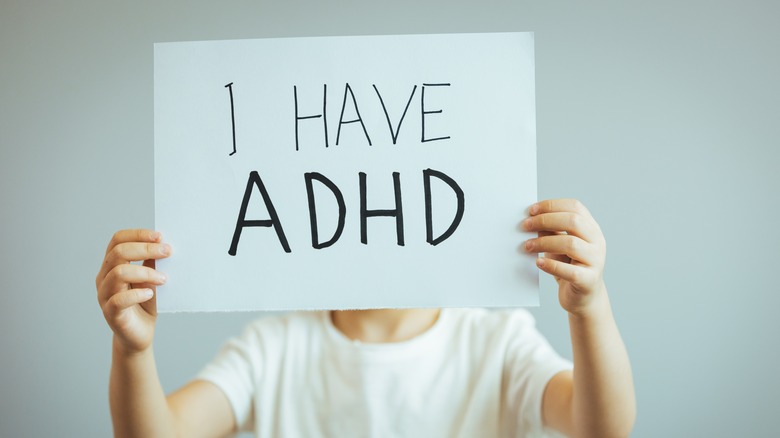
ADHD is a misunderstood condition for multiple reasons. For one, adults with ADHD often look different from children with the condition, per the Attention Deficit Disorder Association (ADDA). For example, while children diagnosed with ADHD are known for their hyperactivity and behavioral issues, many adults with ADHD are not hyperactive, according to GoodRx Health. Furthermore, ADHD symptoms can often mimic those of other mental health conditions, making the disorder difficult to diagnose and easy to misdiagnose.
Researchers and experts debate over whether newly-diagnosed adults had the condition all along as children. Some claim that because these symptoms are more subtle during childhood than adulthood, the condition can be overlooked. “As we get older, we are required to do more things, balance more things, have more responsibilities, and do it on our own,” psychologist Jennifer Hartstein, PsyD, informed GoodRx Health. “We might not have had the same issues as a kid as we do as an adult to stay focused and stay on task.”
Journalist Lisa Ling was not diagnosed with ADHD until the age of 40. “I feel a little bit of relief because, for so long, I’ve been fighting it and I’ve been so frustrated with this inability to focus,” she said in an episode of “Our America With Lisa Ling” (via ADDitude Magazine).
Adult ADHD consists of three distinct types
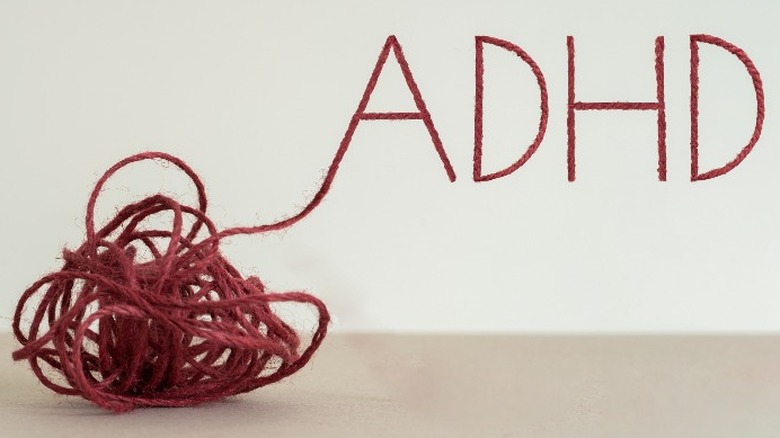
Ozalpvahid/Shutterstock
According to ADDitude Magazine, ADHD can be divided into three distinct types: primarily hyperactive and impulsive, primarily inattentive, and combined type. A clear explanation of each can help to better understand adult ADHD.
Primarily hyperactive and impulsive ADHD most closely aligns with what usually comes to mind when we think of ADHD. Those with this type have a difficult time sitting still and feel the need to constantly move. Adults with this type of ADHD may talk in excess, interrupt others, blurt things out, and struggle with willpower and self-control.
Those with primarily inattentive ADHD typically struggle to manage and sustain attention, follow detailed instructions, and stay organized. Because they have a poor short-term memory and are easily distracted, they may make careless mistakes, be forgetful, and misplace personal items. This type of ADHD was once known as Attention Deficit Disorder, or ADD (per ADDitude Magazine). However, since 1994, medical professionals have used the umbrella term ADHD to describe all individuals with the condition. While some people may still use the term ADD, it is no longer its own formal medical diagnosis.
The third type, combined type ADHD, is a mix of both inattentiveness and impulsivity. People with this type typically show at least six symptoms of each of the two main types.
What causes ADHD in adults?

Nd3000/Getty Images
While the exact causes of ADHD are unknown, the latest research generally points to a genetic link, according to the Centers for Disease Control and Prevention (CDC). Therefore, it’s highly likely that someone with ADHD has at least one biological parent who also has it.
Additional potential causes of and risk factors for ADHD include low birth weight, premature birth, and substance use (alcohol or cigarettes) during pregnancy. Those who have experienced a brain injury may also be more at risk for developing ADHD. In addition, exposure to toxic environmental factors during early childhood or pregnancy may lead to ADHD.
As Psych Central noted, ADHD may also be linked to poor nutrition during pregnancy and early childhood. Marijuana use, obesity, and lack of exercise also can be ADHD triggers or risk factors. Additionally, a study from JAMA Psychiatry shows that childhood ADHD and late-onset ADHD may be caused by different factors.
How is ADHD diagnosed?
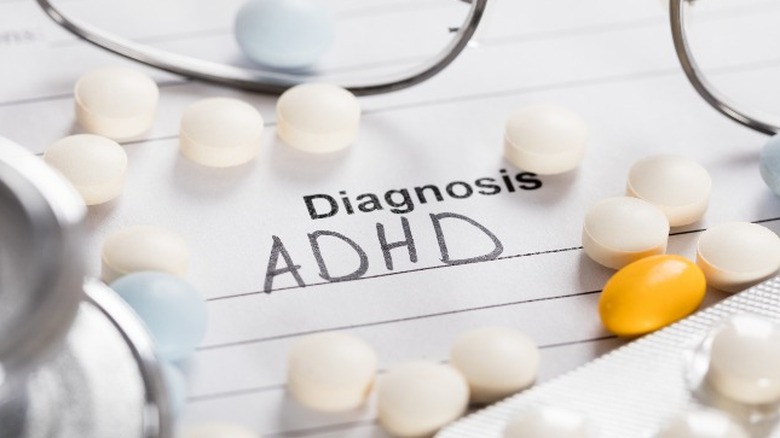
ClareM/Shutterstock
If you display ADHD symptoms, you may want to pursue a diagnosis from a qualified medical professional. For an adult ADHD diagnosis to be made, you will need to undergo an assessment from an ADHD specialist. According to ADDitude Magazine, this could consist of a medical exam to rule out other disorders with similar symptoms, a clinical interview to gather personal and family medical history, and completion of an ADHD rating scale, a type of questionnaire used to assess ADHD symptoms, personality traits, and personal strengths and weaknesses. A complete assessment can take anywhere from one to several visits to complete.
During the assessment, the specialist will use criteria from the “Diagnostic and Statistical Manual of Mental Disorders” (DSM-V) to make a determination. The criteria consist of nine symptoms to diagnose predominantly inattentive ADHD and another nine symptoms for predominantly hyperactive-impulsive ADHD. For an adult to be diagnosed with either the two main types or combined type ADHD, five or more of the nine symptoms must be present in at least two different settings — this could be both work and home, for example — for a minimum of six months. Additionally, per the Centers for Disease Control and Prevention (CDC), for a diagnosis, there must be evidence of how these symptoms have interfered with how the person functions.
Women are more likely to be diagnosed with ADHD later in life

fizkes/Shutterstock
Research shows differences in ADHD diagnoses among the sexes, with girls less likely to receive a diagnosis. If they do, they are more likely to be diagnosed as adults. A 2009 study from The University of Queensland found that girls displaying ADHD symptoms are less likely to be referred for testing and other services. Other research showed that women are more likely to develop the condition as adults (per JAMA Psychiatry).
In addition, ADHD manifests differently in females, who are more likely to be forgetful and disorganized, all symptoms of primarily inattentive ADHD. According to Pat Quinn, PhD, symptoms can intensify after puberty with estrogen release. Added therapist and author Sari Solden: “Often, if girls are smart or in supportive homes, symptoms are masked. Because they’re not hyperactive or causing trouble for other people, they’re usually not diagnosed until they hit a wall, often at college, marriage, or pregnancy” (per The Atlantic).
Maria Yagoda received an ADHD diagnosis while a Yale undergraduate, sharing with The Atlantic how, upon her diagnosis, she and her friends were skeptic because of her high IQ and academic achievement. Psychologist and author Ellen Littman, PhD, explained this public skepticism, a skewed view of ADHD. “The diagnostic criteria were developed based on those studies [of hyperactive young boys],” she said. “As a result, those criteria overrepresent the symptoms you see in young boys, making it difficult for girls to be diagnosed unless they behave like hyperactive boys.”
Does a link exist between trauma and ADHD?
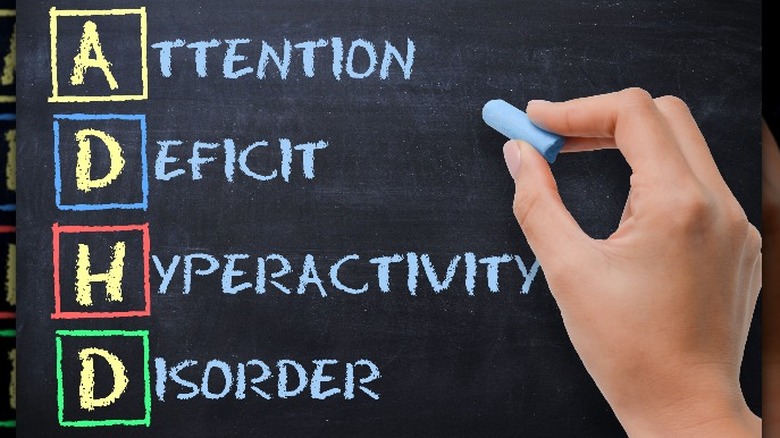
Eviart/Shutterstock
With more research conducted on adult-onset ADHD, researchers learn new information, including interesting links. One such link is the potential connection between trauma and ADHD, according to ADDitude Magazine, as research shows that experiencing trauma can make you more likely to develop ADHD symptoms. However, the relationship between ADHD and trauma is complex, since both diagnoses share symptoms, such as weak memory, poor concentration, inability to regulate emotions, trouble sleeping, and restlessness or impulsivity. ADHD is a brain-based disorder diagnosed during childhood or adulthood, while trauma results from exposure to stressful events or life experiences that can occur any time (per ADDitude Magazine).
Because the brain is still developing during childhood, trauma during childhood may cause cognitive and emotional changes that may be similar to those from ADHD. ADDitude Magazine reported that as much as 70% of adults have experienced one or more traumatic events. These may include losing a loved one, experiencing a divorce, being the victim of crime, or surviving a natural disaster, accident, or health scare. Those witnessing such an event can also develop trauma, which can be in the form of post-traumatic stress disorder (PTSD) or trauma-based nervous system dysregulation. Per ADDitude Magazine, these incidents can affect the way the brain is wired.
Sensory issues can be linked to ADHD

Krotnakro/Shutterstock
Have you ever noticed you’re especially sensitive to sensory stimuli? For example, you might get distracted easily from the phone ringing loudly, or be extra bothered by your clothing feeling too tight or a tag itching your skin. If so, you may be hypersensitive or what’s known as a highly sensitive person (HSP), according to ADDitude Magazine. Hypersensitive people are overly sensitive to the five senses and commonly become distressed about things that others would not. People with ADHD commonly report hypersensitivities. ADHD expert, therapist, and author Sari Solden, MS, shared with ADDitude Magazine some common triggers: “ticking clocks, hissing radiators, or noisy heating units in hotels; someone clicking his pen in a library or kicking the back of your seat on an airplane.”
Hypersensitive people tend to become easily overwhelmed, are especially sensitive to criticism, and can be highly empathetic, even to the point where others’ emotions can affect their own. They also may experience sensory overload, where multiple stimuli compete for attention, making it difficult for the brain to process information. This leads to feeling overwhelmed, losing focus, and becoming frustrated or shutting down altogether. According to Medical News Today, sensory overload is most common in individuals with ADHD and other neurodivergent and mental health disorders.
Common symptoms of ADHD can even increase one’s hypersensitive tendencies and trigger sensory overload. These symptoms include hyperactivity or hyperfocus, impulsiveness, concentration difficulties, lack of environmental awareness, and difficulty regulating emotions.
Hyperfocus is a misunderstood symptom of adult ADHD

Sam Edwards/Getty Images
You’re likely aware that difficulty focusing is a common symptom of ADHD, but you may not be aware that hyperfocus, or focusing too much, is also a symptom (via Psychological Research). This is because ADHD is largely a condition where individuals have difficulty managing their attention. It doesn’t mean that they can’t focus. In fact, when in hyperfocus mode, you can become so engrossed in an activity that you lose all sense of what’s going on around you. “People who think ADHD means having a short attention span misunderstand what ADHD is,” psychologist and author Kathleen Nadeau, PhD, relayed to ADDitude Magazine. “A better way to look at it is that people with ADHD have a disregulated attention system.”
Both hyperfocus and distraction are said to be due to low levels of dopamine in the brain, which makes it difficult for those with ADHD to switch from task to task, especially ones that they don’t find interesting. “Children and adults with ADHD have difficulty shifting attention from one thing to another,” explained ADHD expert Russell Barkley, PhD. “If they’re doing something they enjoy or find psychologically rewarding, they’ll tend to persist in this behavior after others would normally move on to other things.”
Hyperfocus can be a positive: Singer, songwriter, actor, and model Sam Fender credits his success to his hyperfocus ability, referring to it as his “superpower” (via BBC News).
ADHD often occurs alongside depression and anxiety

Tom Merton/Getty Images
We know that other conditions can occur alongside ADHD, including trauma and hypersensitivity. In addition to these, mental health disorders such as anxiety and depression are common in adults with ADHD.
For example, when depression co-occurs in individuals with ADHD, symptoms of each condition are enhanced. In fact, adults with ADHD are approximately 2.7 times more likely to have depression than those without, according to ADDitude Magazine. The outlet noted that legendary actor Johnny Depp, one-time Super Bowl champion and sports commentator Terry Bradshow, and “The Daily Show” host Trevor Noah struggle with mood disorders. “What I’ve come to learn, thanks to some great therapists, is my depression is created by a severe level of ADHD,” Noah said in an interview with CBS’ “60 Minutes.” “If I’m not careful in how I sleep, how I eat, how I manage my routine, I can become overwhelmed and it can feel like the whole world is just too heavy to bear” (via ADDitude Magazine).
Obsessive-compulsive disorder (OCD), a specific type of anxiety disorder, also commonly co-occurs alongside ADHD, something pop superstar Justin Timberlake has experienced. And comedian, actor, and longtime “America’s Got Talent” judge Howie Mandell wrote a book about his struggles with ADHD, OCD, anxiety, and a mood disorder, diagnoses he received as an adult.
Adults with ADHD may be more creative
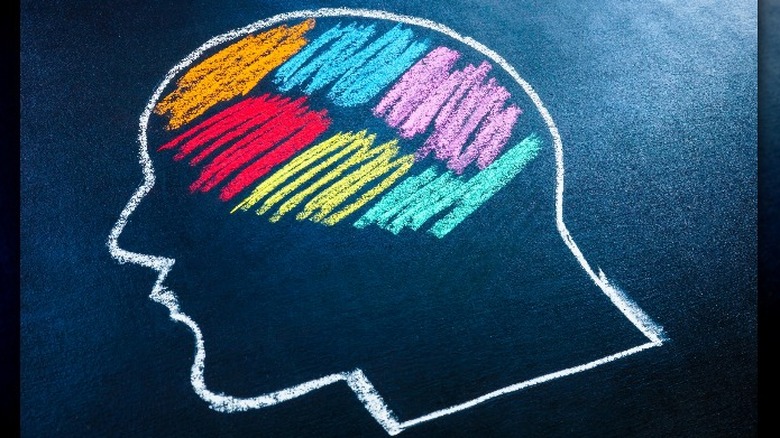
Vitalii Vodolazskyi/Shutterstock
Hyperfocus may also contribute to the creative ability of many with ADHD, a link that research has explored (via Personality and Individual Differences). Studies show that those with ADHD tend to be exceptionally skilled in divergent thinking and overcoming knowledge constraints, two aspects of creative cognition, as research scientist and psychology Holly White described in an article for Scientific American.
White found that those with ADHD may also demonstrate exceptional ability in conceptual expansion, the third aspect of creative cognition. She tasked her students with developing product names for new types of products and conceptualizing a fruit that might be found on another planet. White concluded that her students with ADHD were less constrained to develop out-of-the box ideas and that they showed strong ability in conceptual expansion by coming up with ideas extending beyond conventional boundaries.
It’s important for creative individuals with ADHD to unleash their creativity. According to ADDitude Magazine, stifling this creativity can have negative effects. Author Diane O’Reilly shared how she became happier, less irritable, and more content once she prioritized engaging in creative activities. Additionally, in her book “The Gift of Imperfection,” author Brene Brown writes, “People think creativity is self-indulgent; they don’t think it is productive enough … When people sit on that creativity or deny it, it festers, it metastasizes into resentment, grief, and heartbreak.”
How can ADHD symptoms be treated and managed?
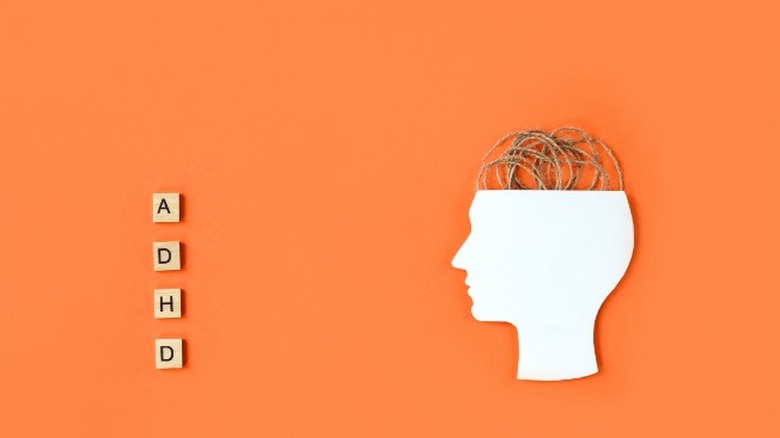
Andreypopov/Getty Images
Fortunately, for adults with ADHD, a variety of options for treatment and symptom management are available. Medication is probably the most well-known treatment option. Various medication options include both stimulant and non-stimulant medication.
Counseling and psychotherapy can be used in addition to or in place of medication. Cognitive-behavioral therapy is one type of counseling therapy that can be used to help address ADHD symptoms and provide strategies to better manage day-to-day life, per the American Academy of Family Physicians. A psychotherapist can help develop individualized strategies to help patients with time management and organizational skills, for example.
Outside of working with a provider, one can access a number of behavioral strategies to aid in time management, organization, task management, and money management. For example, lists and reminders can help with organization, and setting up online banking and keeping a detailed spreadsheet can help to manage spending and expenses.
Some ADHD symptoms may be an asset

Alii Sher/Shutterstock
Not all ADHD symptoms are hindrances. Hyperfocus, a common but misunderstood ADHD symptom, may be a positive, since it can allow people with ADHD to be productive for longer periods of time — that is, when doing work that interests and motivates them. “Many scientists, writers, and artists with ADHD have had very successful careers, in large part because of their ability to focus on what they’re doing for hours on end,” Kathleen Nadeau, psychologist and author of “ADD-Friendly Ways to Organize Your Life,” explained to ADDitude Magazine.
In fact, it’s common for those with ADHD to become self-employed — this way, they have more personal accountability for and freedom over their work. “A job that provides public accountability, along with more immediate and enjoyable consequences, can be ideal for those with ADHD,” said Russell Barkley, PhD, an ADHD expert. “Perhaps this is why 35 percent of people with ADHD are self-employed by the time they’re in their thirties — a figure far higher than the norm.”
Many successful CEOs have talked openly about their ADHD diagnosis — including David Neeleman, founder of JetBlue Airways; Paul Orfalea, founder of FedEx Office (formerly Kinko’s); Diane Swonk, economist and author; Alan M. Meckler, publishing executive and former CEO of Mediabistro; and Charles Schwab of Charles Schwab & Co. Neeleman’s advice for others with ADHD? “Look at the positives of having ADHD, and don’t get discouraged. Don’t ever give up” (per ADDitude Magazine).



